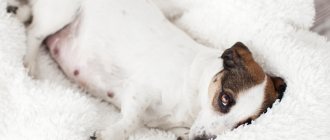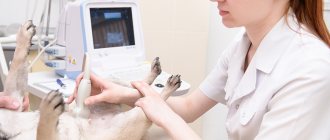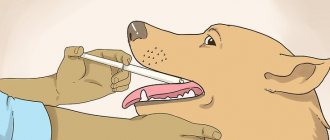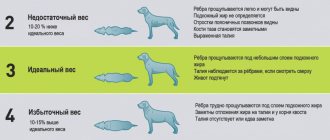Breeding a breed is a responsible and painstaking task that involves you in all aspects of the life of a particular animal. To get good results, breeders need to know how long pregnancy lasts in dogs, how it progresses, and what care the bitch needs. The expectant mother will need the help and support of the owner at every stage of pregnancy. Left unattended, it may not be able to withstand the load and suffer from complications.
How long does gestation last?
On average, the duration of pregnancy in dogs is 55-66 days, that is, about 2 months. The gestation period can shift downward (up to 53 days) or up (up to 71 days) without harm to the puppies if certain factors are present.
What affects timing?
Experienced breeders always note the mating date. It is from this day that they calculate how long pregnancy lasts in dogs. The following factors influence possible deviations from average indicators:
- Number of births
. If a pet is pregnant for the first time, then her babies will not be in a hurry to be born. For more experienced animals, the process takes much less time.
- Size and number of offspring
. The smaller the puppies, the longer they develop in the womb. An earlier exit can only be affected by their number. A small number of babies develop faster.
- Size and age of the pet
. The smaller the animal, the faster the process proceeds. With age, the body weakens, so the dog bears its offspring longer.
- Number of successful matings
. The female can become pregnant after the first mating, but if there is a repeat mating, start counting from there.
In the absence of pathologies, a shift in the estimated date of birth is possible due to later fertilization. This is due to incorrect determination of ovulation. In this case, the sperm will have to wait for the eggs to mature.
Period table
Having figured out how long the duration of pregnancy in dogs is, we can consider its main periods separately. For convenience, they are divided into weeks; the table describes the stages of fetal development and the changes occurring in the expectant mother.
| A week | Puppy development | Pet's condition and care recommendations |
| 1 | After the fusion of the egg and sperm, a zygote is formed. In the first 5-11 days after fertilization, all zygotes are covered with “embryonic” membranes. | Morning sickness may occur. The diet is not changed, but only enriched with vitamins recommended by the veterinarian. Antiparasitic treatment is possible under the supervision of a doctor. |
| 2 | The embryos are still only 0.6 mm long. They are attached to the walls of the uterus, and their outer shell merges with the mucous membrane and forms the placenta. | Interest in male dogs completely disappears. The animal becomes drowsy, may refuse to eat and cuddle up to its owner more often. Daily activity and usual diet are left unchanged. |
| 3 |
| The nipples swell a little, and the skin next to them takes on a more pinkish tint. Lethargy becomes normal. If your appetite increases, your daily food intake may increase. |
| 4 |
| General fatigue and morning sickness are complemented by the appearance of clear mucus that comes out along with urine. The animal is transferred to fractional feeding. Excessively active games and intense training are prohibited. |
| 5 |
| Along with the disappearance of vomiting, appetite increases. Portions are increasing. When dry feeding, food designed specifically for pregnant women is introduced into the diet. Continued vomiting is a reason to contact a veterinarian. |
| 6 |
| Along with your appetite, your weight also increases. The four-legged pet takes more and more care of the offspring, trying to move less and avoid attempts to touch the belly. Reduce the duration of your walk, but try to warm up in the sun. Start preparing the "nest". |
| 7 | In a week, babies grow from 9 cm to 12 cm, and their movement in the abdominal area becomes noticeable even to the owner already at 48-50 days. | The fur next to the nipples begins to fall out. Food enriched with calcium is temporarily excluded. |
| 8 |
| Any activity can lead to premature birth, so keep it to a minimum. Avoid sudden weight changes and increase portions only when necessary. By the end of the 8th week, colostrum appears from the nipples. Take care of finding a surgeon willing to deliver the baby, or start preparing on your own. |
| 9 | The final size of the puppies reaches 16-22 cm and 0.3-0.6 kg. All puppies are born with their eyes closed. | Make sure that your pet understands the purpose of the “nest” and spends most of its time there. Monitor her temperature. As soon as the indicator drops by 1-1.5 °C, get ready for a quick replenishment. |
While caring for your pet, strictly monitor its weight. Sharp jumps are fraught with hormonal disruptions and joint problems.
Calculation of due date
It will not be possible to find out the exact date of birth of the puppies, but it is quite possible to calculate the approximate date. Add to the mating date the average duration of how long the dog stays pregnant. Then try to adjust the resulting figure up or down depending on factors affecting the timing.
Throughout the entire period, the owner must observe the condition of the pet, comparing it with the table. If deviations from the schedule occur, contact your veterinarian immediately to prevent the development of complications.
Pekingese breeding methods
Inbreeding. In this method, mating takes place between dogs that are closely related.
To apply this method, the owner needs to know everything about the good and bad qualities of the dogs from which the mating pair came. This method is not used by all dog breeders, because the risk of failure is high and a lot of experience is needed to perform such a procedure.
Line breeding . This method of breeding occurs between dogs that are in the same family line . If a male dog has dominant traits, his great-great-grandchildren will look like him. If you are the sire of this offspring, then most likely you have never met this male.
Advice! But you can look at photographs, learn about him from dog breeders and clearly see the puppies that were born from him.
Outcrossing. This type of Pekingese mating does not imply any relationship between the female and the male .
In order to find out the origin of a dog, it is enough to look at only 5 generations in the pedigree . It is important to know here that not all factors influencing future offspring are manifested externally. It also happens that the combination of genes of a male and a female does not form an acceptable combination and then you will not get excellent offspring.
Signs of an interesting situation
It is quite difficult to guess that a pet is carrying puppies in the early stages. At first, only behavioral changes are noted that are noticeable to attentive owners. The expectant mother becomes inactive and refuses long walks. She gets nervous in noisy companies and tries to find a secluded place. Her appetite increases or decreases sharply, and she often vomits in the morning.
After detecting these symptoms, be sure to visit a veterinary clinic. More obvious signs appear only a month after fertilization. A pregnant woman's belly becomes rounded and enlarged. Viscous mucus is released from her loop, and the nipples swell.
By the end of 2 months, babies can be palpated, but this is recommended only under the supervision of a veterinarian. Fragile fruits are easy to injure, so avoid self-examination.
Prenatal fees
Main stages
- prepare in advance a place for birth and a corner for newborn Pekingese babies. Such an area should be warm and well lit. It is necessary to set aside a place for bedding;
- You need to cut the dog's fur on the belly, shorten it slightly in length in the loop area. This technique will visually facilitate the process of giving birth to a Pekingese;
It is necessary to take care of a mandatory set of tools and medications. The standard set should include:
- oilcloth - placed under the Pekingese during the birth process ; fabric material is placed on top. For puppies, it is advisable to select another fabric, pre-boiled;
- it is necessary to prepare scissors and sterile threads;
- syringes with filled insulin - 2 pieces;
- drug Oxytocin;
- antispasmodics (drotaverine);
- boiled vegetable oil or vaseline oil;
- a pipette, syringe, or cotton wool may be required;
- you need to have a heating pad on hand, preferably a rubber one, to warm newborn puppies;
- antiseptics for external treatment (for example, brilliant green);
- container for the placenta.
Ideally, it is necessary to entrust the management of labor to a veterinarian.
Differences in timing between dogs of different breeds
To determine the timing of thoroughbred animals, you need to start from their dimensions. The larger they are, the longer it takes to form fruits.
In small
Small breeds (Chihuahuas, Pekingese, Yorkies) carry their young for 55-60 days. Their offspring are always the most numerous.
Due to its modest dimensions, future mothers often encounter gastrointestinal problems. Their enlarged uterus begins to crowd the stomach, so food is made as high in calories as possible, but small in volume.
In the middle ones
Average dogs (boxers, huskies, spaniels) are less likely to suffer from complications, and the number of embryos is always determined by chance. The entire process takes 60-63 days.
In large
Large representatives (wolfhounds, mastiffs, mastiffs) remain pregnant for 63-65 days, but sometimes the period is extended to 72 days. This is due to the cubs being too large and requiring a long time to develop. Despite the small number of offspring, childbirth often occurs with complications due to the problematic passage of overgrown babies through the birth canal.
Factors influencing gestational age
The duration of gestation of puppies depends on many factors.
- Number of previous births. The first pregnancy will be significantly longer than subsequent ones. The difference can be up to 7 days.
- Pet activity. If the dog is active, she will most likely give birth to puppies earlier.
- Age and size. Small dogs give birth faster than large ones. And animals aged 7-8 years bear their offspring longer.
- Number of puppies. The more puppies in the litter, the shorter the pregnancy. If there are few of them, they grow larger and take longer to form.
Visit to the veterinarian
After detecting the listed signs, make an appointment with a veterinary clinic. Plan a visit no earlier than a month after mating. By this time, relaxin, a sex hormone, will appear in the blood of the expectant mother, on the basis of which an interesting position is confirmed.
Determining the number of fruits
In addition to examination, palpation and blood tests, diagnosis involves ultrasound and x-rays. These procedures help determine the exact number and condition of the fruits, but not earlier than the beginning of the 2nd month.
Exclusion of pathologies
A visit to the veterinary clinic is recommended even if your four-legged pet is in good health. Not all pathologies are determined visually. Diagnostic procedures help to detect hidden complications and prevent their development.
What orthodontic structures are used at this stage?
A permanent retainer is usually placed on the lower teeth. This is a thin metal wire made of the same alloy as the braces arch and about the same thickness. The retainer is installed from the reverse (lingual) side using filling material. The surface of the retainer and fastenings is smooth, does not interfere with cleaning and is not felt at all.
This is what a dental retainer looks like
But the retainer only holds the lower teeth in place. To stabilize the position of the upper ones, use a transparent mouth guard. It is made from impressions that are taken from the teeth immediately after treatment is completed. That is, the mouthguard repeats the ideal shape of the dentition that was obtained as a result. The mouth guard must be worn at night.
Caring for the expectant mother
During the period of bearing offspring, protect your pet from stress factors. Avoid meeting new people and staying in noisy places.
Remember that any cold will be more severe than usual. Do not let your pet sleep on a cold floor and make sure that her place is protected from drafts.
Particular attention will have to be paid to feeding and physical activity. Also, do not forget to prepare the “nest”, that is, the future place for childbirth.
Feeding
For full development, embryos will need vitamins A, B, D and E. They can be added directly to food, checking the brand with your veterinarian. To form bone structure, the diet is enriched with calcium. It will also be necessary to increase the amount of proteins that perform a construction function. You need to return to the previous amount of protein food 10 days before birth, and 5 days before giving it up completely.
In the first month, feedings are carried out 2 times a day, in the second - 3 times a day, and shortly before birth - 4-5 times a day. Try to keep carbohydrates to a minimum to prevent obesity. The easiest way to feed your animal is pregnancy food.
Walking and activity
Reduce the length of the route while maintaining the duration of the walk. A pregnant pet will become slower, so it will take more time for her to cover the usual distances. If you feel tired, listen to the animal and return home.
It is better to increase the number of walks up to 3 times. This will be needed to relieve the burden on the bladder, which is being compressed by the enlarged uterus. If this is not possible, stock up on diapers. A tray is suitable for small dogs.
Running, jumping and walking on stairs are prohibited. Try to carry your pet in your arms or use the elevator more often.
Hygiene
No innovations in hygiene procedures are required. Treat your eyes and ears as usual. Wash your paws after every walk. Entire bathing is best done only as a last resort. After washing, be sure to dry your pet with a towel and hairdryer to prevent hypothermia.
Preparing for childbirth
In the second half of the 4th week, prepare the birth area. If your pet does this on her own, she will definitely choose a secluded corner behind the sofa, where it will be difficult for her to provide help if necessary. Make sure that the design you choose is safe, retains heat well, and appeals to the expectant mother.
7 days before giving birth, contact your surgeon or prepare all the necessary instruments yourself. Try to arrange a vacation from work in advance to support your pet in the first days.
What should the owner do?
How to deliver a dog at home? At each of the stages described above, certain actions will be required from the owner.
First stage:
Second phase:
Third stage:
What to do when a dog gives birth for the first time? Dogs giving birth for the first time deserve special attention. They need to be carefully monitored and their actions controlled, since they have no experience, and their instincts can be smoothed out. Otherwise, if everything is done correctly, the birth will be safe for both the bitch and the puppies.
Additionally, check out the video about giving birth to a dog:
What to do when a dog gives birth for the first time? Dogs giving birth for the first time deserve special attention. They need to be carefully monitored and their actions controlled, since they have no experience, and their instincts can be smoothed out. Otherwise, if everything is done correctly, the birth will be safe for both the bitch and the puppies.
Condition of the dog before birth
The imminent appearance of offspring can be recognized by sudden aggression towards strangers, the construction of a “nest” and the creation of hiding places with food supplies. A few days before giving birth, the pet begins to produce milk and loses its appetite.
In the last day, body temperature drops by 1-1.5 °C. The expectant mother becomes very restless, digs “holes” in the floor and sits down in them. At this stage, take her to the “nest”, since there will be no more than 1.5 hours left before new family members appear.
Pekingese mating
First, find a suitable male for your dog . Breeding Pekingese is a difficult business, so the dog must end in pregnancy, since even the first litter can be the only one if it ends well for the mother. After all, if you breed dogs, the matter should lead to the improvement of the breed, and not just to produce offspring.
Secondly, it is important that the dog is in good condition . She must be of suitable size and her body weight must not be less than 3.5 kg, otherwise she will not survive childbirth and will not be able to care for the offspring.
Important! Pekingeses come into heat once every 6 months, but the timing may change. The first time estrus can occur at 18 months, or maybe at 27 months. However, the right time to give birth to puppies is 18 months.
Possible complications
If you notice any alarming symptoms, including a significant deviation from the planned date, call your veterinary clinic immediately. It is better to be wrong in your guesses than to allow the death of your four-legged pet and her babies.
Ectopic pregnancy
The development of embryos outside the uterus is fraught with death due to internal ruptures and bleeding. It is accompanied by pain and bloody discharge from the uterus. If the animal whines and blood flows from its loop, call a doctor.
False pupishness
False whelping, or false pregnancy, can be easily determined independently only by the absence of mating. This condition is accompanied by similar symptoms, but instead of labor, it can result in mastitis or other complications. Due to the likelihood of such an outcome, veterinarians recommend not to refuse blood donation, ultrasound and x-rays.
Frozen pregnancy
Partial or complete death of embryos is fraught with mummification with subsequent intoxication of the body. If the dead fetuses do not come out on their own, they are removed by artificial stimulation of the uterus or by sterilization.
If the dog paces
A delay of more than 10 days is an alarm bell. In addition to the death of the fetus, the reason may lie in a delay in its development, pathologies of the genital organs of the bitch, or other diseases of the four-legged woman in labor. Healthy babies are removed by caesarean section.
How Pekingese give birth
Signs of imminent labor
How long does it take for Pekingese to give birth?
An inexperienced Pekingese owner should know that the birth process in this breed of dog continues for a very long time. The onset of contractions is marked by a change in the dog's breathing rate and pulse. The pain is minimal. In the first hours of labor, the mucous plug comes out of the loop or a considerable amount of water pours out. These symptoms indicate the active onset of labor.
The tone of the abdominal muscles that occurs at certain intervals is called pushing. This period of labor takes on average about 4 hours. You need to monitor the intervals of pushing; when they are reduced, the puppies will soon begin to appear.
Actions of the owner during home birth:
On the Internet you can find a large number of photos of cute newborn Pekingese puppies . The birth process is labor-intensive and requires a lot of skills and knowledge from the owner. But as a result, the dog owner will receive new four-legged friends.
Source
Vaccinations, antiparasitic treatment and treatment during pregnancy
Vaccination is carried out strictly before mating, since the administered drugs can cause abnormalities in development or death of the fetus. Mother's immunity is transferred to babies during feeding and lasts up to 2-2.5 months.
Treatment against parasites is also recommended before mating, namely 14 days before the meeting of future partners. Anthelmintics are quite toxic, so they can negatively affect the health of puppies. Pregnant bitches are only allowed to take anthelmintic drugs if they are directly infected. In this case, the animal is given more gentle anthelmintics: Milbemax, Prazitel, Drontal Plus.
Any treatment is carried out only under the guidance of a veterinarian. The drugs are selected individually, taking into account their effect on the body of the expectant mother and her babies.
Pekingese mating process
Estrus occurs once every 6 months, the interval can last up to a year. But how long a Pekingese's estrus lasts can be determined by bleeding; ovulation occurs on days 11-13 from the start of estrus.
The rule of mating is that it should occur on the 11th and 13th days of estrus , so watch your pet carefully and do not miss the beginning. You can determine for yourself when your pet is ready for the mating process. In this case, the color of the discharge becomes pink, and then completely colorless.
If you run a dog along the spine, it will react by throwing its tail to the side, making it clear that it is ready to mate. The process of mating Pekingese dogs should take place in a calm environment , and there should be no other males nearby except the stud dog.
Important! The dog should not be washed, especially using cosmetics. This will kill the smells, which should, on the contrary, attract the male.
Before leaving for mating, the dog needs to be walked. It is better to arrive in advance so that the dog has the opportunity to look around the foreign territory and get used to its future partner . Otherwise, she may think that she is being abandoned and will not allow the male to approach her. However, you need to remember that it is not always possible to “introduce” Pekingese dogs to each other before mating. The fact is that males of this breed have a very fine mental organization and can simply spend all their strength even at the stage of courting a female.
The male needs time to rest during the mating process . It is better if there are two people next to the female and the male; the dog must not be allowed to bite the male. Mating can take place on a table, for this you need to lay out special material so that the animals remain stable during the process.











